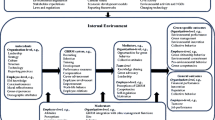Abstract
Indian construction industry has seen remarkable growth and it is an integral part of the economy with massive foreign investments which demands quality construction. The pressure to reduce time and cost of construction increases the risk on the part of stakeholders with respect to quality and safety of the construction. The problem is serious and dangerous in developing countries like India which requires focus and attention for sustained growth in construction sector. This research reports on the adoption and development of structural equation model to study the fundamental relationship between five enablers of European Foundation for quality management (EFQM) framework to improve the quality performance in Indian construction projects. Data collected from clients, contractors and consultants of Indian construction industry through questionnaire survey was used to analyze the conceptual framework using smart PLS software. The conceptual model in this research includes eight hypotheses and T-statistics values is used for checking the significance of the hypothesis. The findings of the study revealed that leadership factor has strongest total effect on people factor (Path coefficient = 0.77) and process factor has strongest effect in achieving the goals of quality performance improvement in construction projects (Path coefficient = 0.7). The results indicate that Indian construction organizations must give top priority to leadership and process related problems in various phases of the project to result in continuous improvement in quality performance.



Similar content being viewed by others
References
Aibinu A A and Al-Lawati A M 2010 Using PLS- SEM technique to model construction organization’s willingness to participate in e-bidding. Autom. Construct. 19 (6): 714–724. doi: 10.1016/j.autcon.2010.02.016
Akter S, Ambra J D and Ray P 2011 Trustworthiness in m-Health information services: An assessment of a hierarchical model with mediating and moderating effects using partial least squares (PLS). J. Am. Soc. Inf. Sci. Technol. 62 (1): 100–116
Chin W W 1998 The partial least squares approach to structural equation modeling. Lawrence Erlbaum Associates, Mahwah, New Jersey
Chinda T and Mohamed S 2007 Causal relationships between enablers of Construction safety culture. In: Proceedings of the fourth international conference on accelerating innovation in engineering, management and technology, Gold Coast, Australia, pp. 438–445
Cohen J 1988 Statistical power analysis for the behavioural sciences. Lawrence Erlbaum Associates Hillsdale, New Jersey
Fornell C and Larcker D F 1981 Structural equation models with unobservable variables and measurement error: Algebra and statistics. J. Market. Res. 18 (3): 328–388. doi: 10.2307/3150980
Henseler J, Ringle C M and Sinkovics R R 2009 The use of partial least squares path modeling in international marketing. Adv. Int. Market. 20 (1): 277–319. doi: 10.1108/S1474-7979
Hulland J 1999 Use of partial least squares (PLS) in strategic management research: A review of four recent studies. Strategic Manag. J. 20 (2): 195–204. doi: 10.1002/(SICI)1097-0266(199902)
Ismail W K W, Darestani H and Irani M A 2011 Quality excellence model: A review of researches in Developing countries. Int. J. Fundam. Psychol. Social Sci. 1 (2): 35–38
Mahalli A F 2013 Applying the EFQM model in performance measuring of organization. Standard Res. J. Business Manag. 41 (1): 41–51
Rahman I A, Memon A H, Abdul Azis A A and Abdullah N H 2013 Modeling causes of cost overrun in large construction projects with partial least square-SEM approach: Contractor’s perspective. Res. J. Appl. Sci. Eng. Technol. 5 (6): 1963–1972
Ringle C M, Wende S and Will S 2005 SmartPLS 2.0 (M3 Beta), Hamburg, Retrieved from: www.smartpls.de
Tenenhaus M, Vinzi V E, Chatelin Y M and Lauro C 2005 PLS path modelling. Comput. Stat. Data Anal. 48 (1): 159–205. doi:10.1016/j.csda.2004.03.005
Vijande M L S and Gonzalez L L A 2007 TQM and firms performance: An EFQM excellence model research based survey. Int. J. Business Sci. Appl. Manag. 2 (2): 21–41
Author information
Authors and Affiliations
Corresponding author
Rights and permissions
About this article
Cite this article
SHANMUGAPRIYA, S., SUBRAMANIAN, K. Structural equation model to investigate the factors influencing quality performance in Indian construction projects. Sadhana 40, 1975–1987 (2015). https://doi.org/10.1007/s12046-015-0421-3
Received:
Accepted:
Published:
Issue Date:
DOI: https://doi.org/10.1007/s12046-015-0421-3




